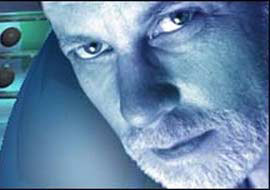Dr. Don Bergland
I began creating art seriously in the 1960s. Much of my time was spent figuring out ways to record, composite, layer, present, and finally deliver my creative products. Each step of the way was controlled by gatekeepers whose power allowed access to both resources and publication. At that time, my studio was filled with a host of traditional mechanical devices to help me accomplish my objectives. Floors and tables were littered with paints, easels, reel-to-reel tape recorders, light tables, dissolve boxes, and other Rube Goldberg-like devices. Although I certainly enjoyed the processes of innovation engendered by such activity, I continually felt that my visionary intentions were severely limited by the range of tools I had available.
My first introduction to digital tools in the 1980s brought about an amazing epiphany! I realized the incredible potential immediately. Even though the tools were primitive and suffered from certain limitations, I felt that these tools had the latent ability to help me create products that matched my vision. Throughout the 1980s and 1990s, I engaged in an intensive dialogue with digital tools and gurus. I went to work in industry where I spent countless hours learning new image techniques, audio processes, motion procedures, and interactive & virtual structures. And finally, the divisions and boundaries that traditional media had installed in my mind dissolved into one fused environment of liquid creativity where all media forms resided in a fluid harmonious integration.
Today, I have entirely converted all my tradtional art-making processes into digital procedures. My studio consists only of my mind and body connected intimately to my computer. My output is astonishing and the satisfaction I feel in my studio abilities can never be overstated. I can easily create music, sound, and visual images, intertwine these in unified productions, publish them on the Internet, and receive global feedback instantly. The gatekeepers have long ago disappeared and I remain the sole arbiter of my productivity. For the first time in my life, I feel in absolute control of my creative vision and the tools I use are now but mere extensions of my mind.
It is this new and magnificent creative world that I as an educator wish to make available to all those who study the arts. It is a world that I feel can only be experienced within the expansive universe offered by digital tools and processes. So let's explore what this kind of a vision means to the field of arts education. Let's examine what it is to be on the edge of cosmic empowerment, where creative production has become such a dynamic and democratic process. And finally, let's work together to bring this 21st century vision of creativity into the arts programs currently offered by our schools.
Sunday, October 7, 2007
Subscribe to:
Post Comments (Atom)

No comments:
Post a Comment